Question
The Chinese soft-shelled turtle, Pelodiscus sinensis, lives in salt water marshes. The turtle can live under water and out of water.
These turtles have fully developed lungs and kidneys, however, many microvilli have been discovered in the mouth of P. sinensis. A study was undertaken to test the hypothesis that oxygen uptake and urea excretion can simultaneously occur in the mouth.
Initial experiments involved collecting nitrogen excretion data from P. sinensis. The turtle urinates both in water and out of water. When in water it allows waste products to be washed out of its mouth. When out of water it regularly dips its head into shallow water to wash its mouth. The table shows the mean rates of ammonia and urea excretion from the mouth and kidney over six days.

It was noted that during long periods out of water, turtles rhythmically moved their mouths to take in water from a shallow source and then discharge it. Changes in the dissolved oxygen and the quantity of accumulated urea in the rinse water discharged by the turtles were monitored over time as shown in this graph.
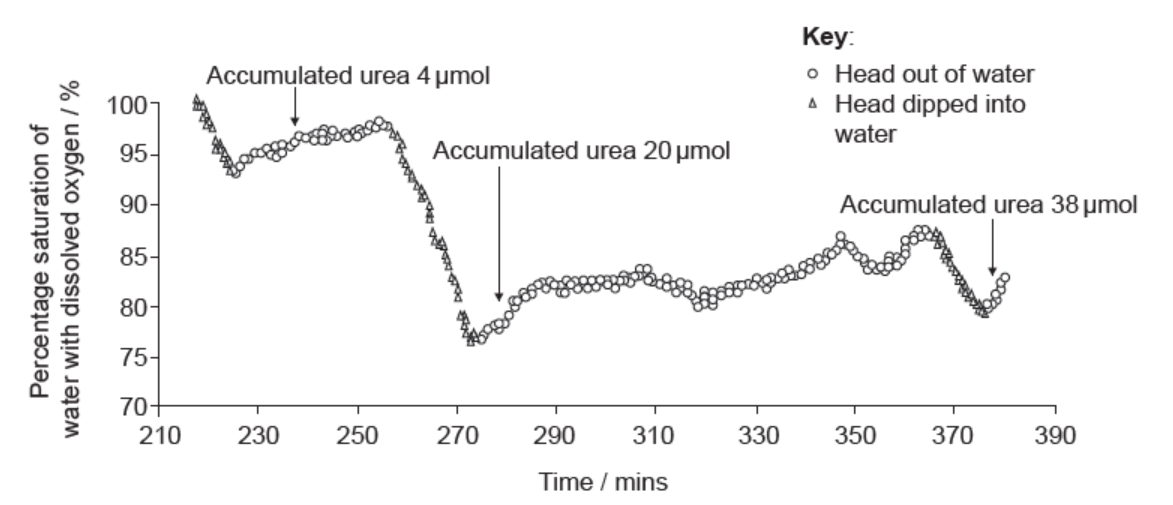
In order to test whether a urea transporter was present in the mouth tissues of the turtles, phloretin (a known inhibitor of membrane proteins that transport urea) was added to the water in which a further set of turtles submerged their heads. The results of that treatment are shown.
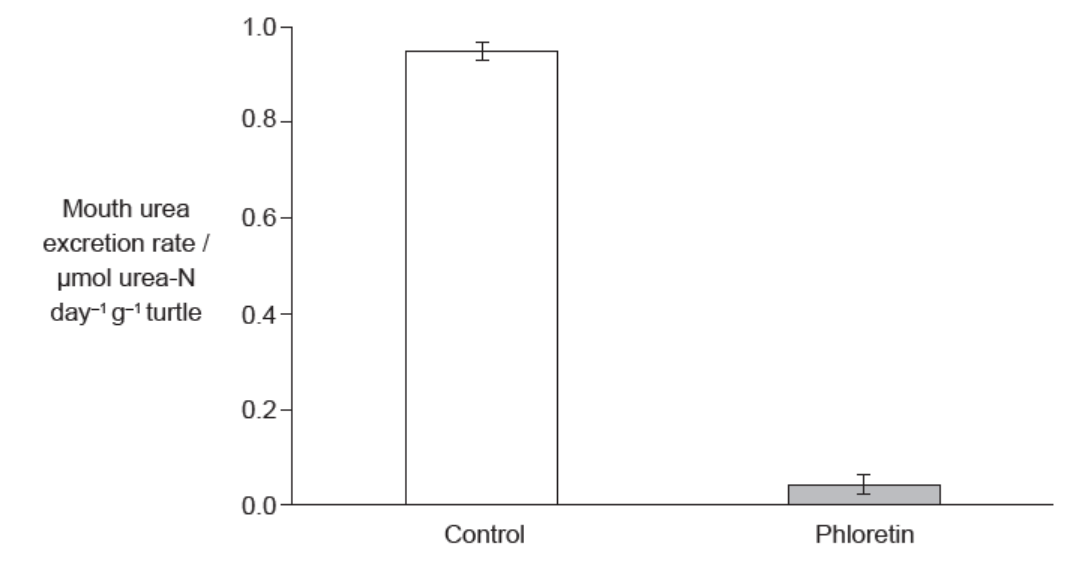
Further research was conducted to determine where mRNA expression of a urea transporter gene might be occurring in P. sinensis. Gel electrophoresis was used to analyse different tissue samples for mRNA activity.

Expression of the urea transporter gene by cells in the turtle’s mouth was assessed by measuring mRNA activity. Turtles were kept out of water for 24 hours and then injected with either a salt solution that matched the salt concentration of the turtle, dissolved ammonia or urea, followed by another 24 hours out of water.
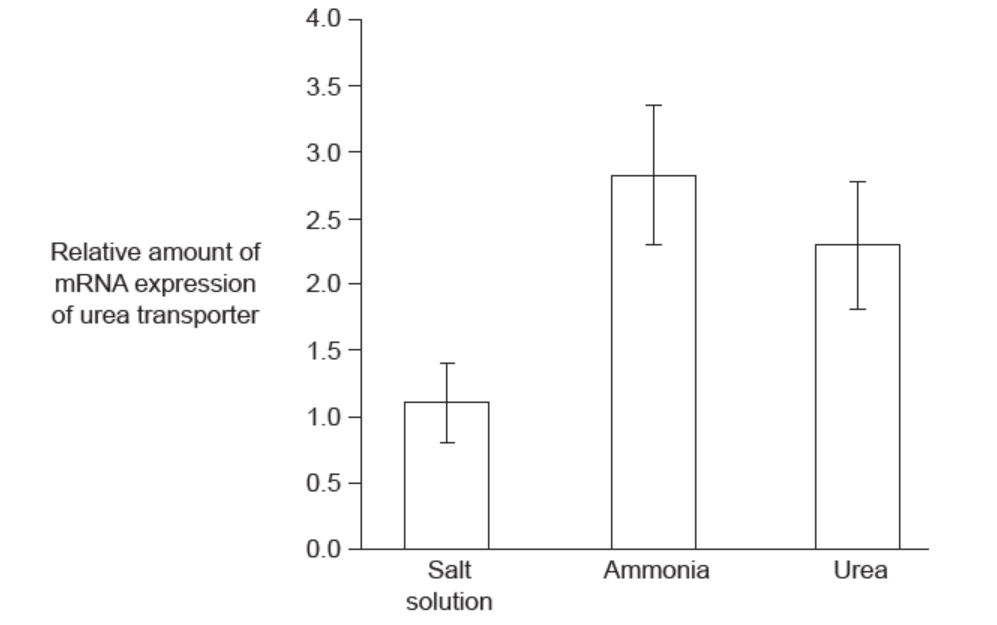
a.Deduce whether the excretion of ammonia or urea changes more when a turtle emerges from water.[2]
b.Compare and contrast the changes in urea excretion in the mouth with the changes in urea excretion in the kidney when a turtle emerges from the water.[3]
c.i. Describe the trends shown by the graph for dissolved oxygen in water discharged from the mouth.[1]
c.ii.Suggest reasons for these trends in dissolved oxygen.[2]
d.Deduce with a reason whether a urea transporter is present in the mouth of P. sinensis.[2]
e.Outline the additional evidence provided by the gel electrophoresis results shown above.[2]
f.i.Identify which of these turtle groups represent the control, giving a reason for your answer.[1]
f.ii.Suggest a reason for the greater expression of the gene for the urea transporter after an injection with dissolved ammonia than an injection of urea.[2]
$\mathrm{g}$ The salt marshes where these turtles live periodically dry up to small pools. Discuss the problems that this will cause for nitrogen excretion in the turtles and how their behaviour might overcome the problems.[3]
▶️Answer/Explanation
markscheme
a. urea
b. for both mouth and kidney
c. percentage change/change in $\mu \mathrm{mol}$ day-1 $\mathrm{g}-1$ greater with urea/other acceptable numerical comparison
a. both higher/increased on emergence from/with turtle out of water
b. both increased by 0.66 « $\mu \mathrm{mol}-1 \mathrm{~g}-1$ when turtle emerges from water»
c. \% increase is higher in kidney / kidney 940\% versus mouth 73/75\% / increase is higher proportionately higher in kidney / kidney x10 versus mouth nearly double/x1.z3
d. urea excretion by mouth greater than kidney out of water «despite larger \% increase in kidney excretion»
b.
decrease «when head is submerged» and increase when head is out of water
c.i.
a. oxygen absorbed from water/exchanged for urea when head dipped in water«so oxygen concentration decreases»
b. lungs cannot be used with head in water / can «only» be used with head out of water
c. oxygen from water «in mouth» used in «aerobic cell» respiration
d. oxygen from air dissolves in water when head out of water «so oxygen concentration increases»
c.i1.
a. urea transporter is present
b. less urea «excreted»/ lower rate «of urea excretion» / excretion almost zero when phloretin/inhibitor was present
d.
a. mRNA only in mouth and tongue/in mouth and tongue but not esophagus intestine kidney or bladder
b. bands / lines indicate mRNA for/expression of urea transporter gene
c. urea transporter gene expressed / urea transporters in mouth/tongue / not expressed/made in esophagus/intestine/kidneys/bladder
d. mRNA/transcription/gene expression/urea transporters higher in tongue/more in tongue «than mouth»
e. lives in salt water/salt marshes / because nothing has been altered
f.i.
a. ammonia is «highly» toxic/harmful
b. ammonia is more toxic than urea/converse
c. ammonia converted to urea
d. urea concentration raised «by injecting ammonia»
e. difference between ammonia and urea «possibly» not «statistically» significant
f.ii.
Problems:
a. urea becomes more concentrated «in small pools» / lower concentration gradient «between tongue/mouth and water»
b. less water available for urine production/excretion by kidney
OR
less water in ponds for mouth rinsing/more competition for pools (to use for mouth rinsing)
Behaviour to overcome problems:
c. «still able to» dip mouth into/mouth rinse in water/pools
d. «still able to» excrete urea «though the mouth» in the small pools
e. more conversion of ammonia to urea/urea excretion rather than ammonia
f. more urea transporters/expression of urea transporter gene
g. urea excreted «in mouth/via microvilli» by active transport/using ATP
h. excretion with little/no loss of water
Question
a.Outline the action of enzymes.[4]
b.Explain the roles of specific enzymes in prokaryote DNA replication.[7]
c. child with the disease.[4]
▶️Answer/Explanation
markscheme
a
Catalyse/speed up reactions
Substrate-specific
Lower the activation energy «of a chemical reaction»
Substrate collides with/binds to active site
Enzyme–substrate complex formed
OR
transition state formed
OR
bonds in substrate weakened
«DNA» gyrase/topoisomerase «II» prepares for uncoiling/relieves strains «in the double helix»
Helicase uncoils/unwinds the DNA/double helix
Helicase separates/unzips/breaks hydrogen bonds between the two strands of DNA
«DNA» primase adds an RNA primer/short length of RNA Accept RNA primase.
DNA polymerase III adds «DNA» nucleotides/replicates DNA/synthesizes complementary strand in a 5’ to 3’ direction
DNA polymerase III starts replication/adding nucleotides at the primer
DNA polymerase I removes the primer
OR
replaces RNA with DNA
«DNA» ligase seals the nicks
OR
links sections of replicated DNA
OR
links Okazaki fragments
DNA polymerase I/DNA polymerase III proofreads for mistakes
c. Key or text giving alleles with upper case for dominant allele and lower case for recessive allele/allele causing disease
Reject key showing a sex linked gene such as hemophilia.
Reject if X or Y chromosomes are shown with the alleles.
Accept Aa or any other upper and lower case letters.
Punnett grid showing that both parents can pass on either a dominant or a recessive allele in their gamete
For example row and column headings with A and a.
This mark can be awarded if X or Y chromosomes are shown but each parent has one recessive and one dominant allele as if for autosomal inheritance.
Four possible genotypes for child correctly shown on grid
AA, Aa, aA and aa for example.
This mark can be awarded if X or Y chromosomes are shown but the genotypes are correct for autosomal inheritance.
Double/homozygous recessive shown having the disease
Cannot be awarded with sex linkage.
25 % or 0.25 or 1/4 chance of inheriting the disease
This mark can be awarded if X or Y chromosomes are shown but the ratio is correct for autosomal inheritance.
Question
The diagram shows a nucleosome from the nucleus of a eukaryotic cell.
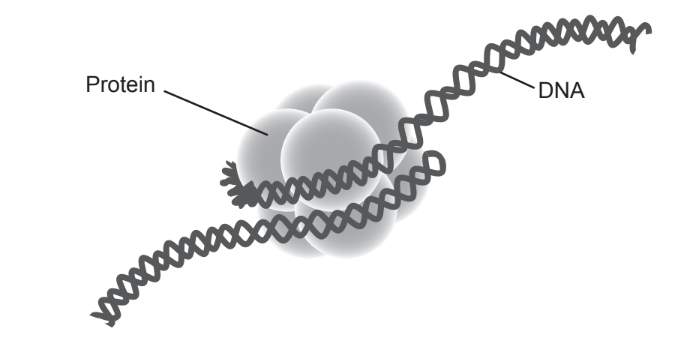
(a) Identify the protein labelled in the diagram. [1]
(b) Outline how nucleosomes affect the transcription of DNA. [1]
The image shows the regulation of the gene responsible for producing lactase.
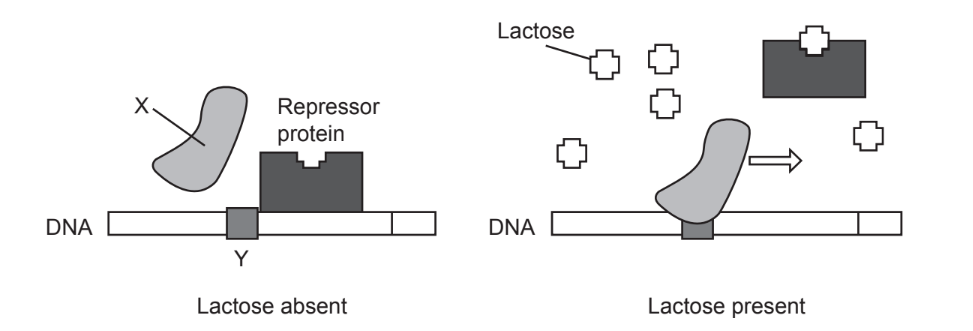
(c) Identify:
(i) X, the enzyme which copies a DNA sequence [1]
(ii) Y, non-coding DNA at the start of a gene. [1]
(d) Explain the role of lactose in the expression of the gene for lactase production. [3]
(e) State one reason that identical twins may show different methylation patterns as they grow older. [1]
▶️Answer/Explanation
a histone; 1
b a. (nucleosomes can) promote AND inhibit transcription of genes/expression of genes;
b. (nucleosomes can) prevent transcription by (tight) condensation/supercoiling/packing of DNA;
c. (nucleosomes can) allow/prevent binding of RNA polymerase/transcription factors;
d. tagging/acetylation/methylation of nucleosomes/histones can promote/inhibit transcription;
e. movement of histones/nucleosomes (along DNA) can affect which genes are transcribed;
c i RNA polymerase;
c ii promoter;
d a. lactose binds to repressor protein;
b. repressor protein (with lactose bound) cannot block/bind to the promoter/Y;
c. RNA polymerase/X binds to the promotor/transcribes the gene;
d. lactase produced (if lactose present)/lactase production inhibited if lactose absent;
e (different) environment/illness/disease/diet;
